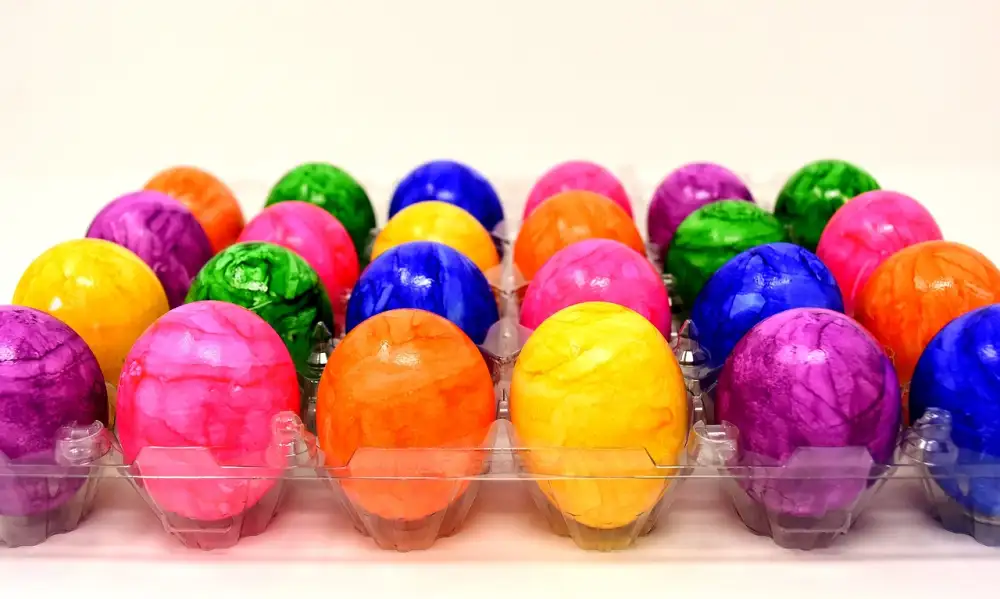Delight in the Divine Flavors of Easter Bread: A Traditional Recipe to Elevate Your Home Baking

- History and Significance of Easter Bread
- Ingredients Required for Easter Bread Recipe
- Step-by-Step Instructions for Making Easter Bread
- Tips and Tricks for Perfectly Fluffy Easter Bread
- Variations and Additions to Enhance Your Easter Bread
- Serving and Enjoying Easter Bread with Family and Friends
- Storing and Preserving Easter Bread for Extended Freshness
Easter is a time of joy, celebration, and indulgence. And what better way to celebrate than with the heavenly flavors of Easter bread? This delectable treat has been a beloved tradition for centuries, bringing families together around the table to savor its rich aroma and delicate taste. Whether you're a seasoned baker or just starting out, this article will guide you through the art of making Easter bread from scratch. Get ready to embark on a culinary adventure that will delight your taste buds and create lasting memories with your loved ones.
History and Significance of Easter Bread
Easter bread holds a rich history and deep significance in various cultures around the world. Its origins can be traced back to ancient times, where it was often associated with pagan spring festivals celebrating the rebirth of nature. With the spread of Christianity, Easter bread became intertwined with the religious observance of Easter, symbolizing the resurrection of Jesus Christ. The shape of the bread, often braided or formed into a round loaf, represents unity and eternity. It is also adorned with decorative elements such as colored eggs or crosses, adding to its symbolism of new life and hope. Today, baking and sharing Easter bread is a cherished tradition that brings families together to celebrate this joyous holiday.
Ingredients Required for Easter Bread Recipe
To make the perfect Easter bread, you will need the following ingredients:
- 4 cups of all-purpose flour
- ½ cup of granulated sugar
- 2 teaspoons of active dry yeast
- 1 teaspoon of salt
- ½ cup of unsalted butter, melted
- ¾ cup of warm milk
- 3 large eggs
- Zest of 1 lemon and 1 orange
- 1 teaspoon of vanilla extract
- Optional: colored sprinkles or candied fruit for decoration.
Step-by-Step Instructions for Making Easter Bread
1. In a large mixing bowl, combine 4 cups of all-purpose flour, ½ cup of sugar, and 2 teaspoons of instant yeast.
2. In a separate bowl, whisk together 3 eggs, 1 cup of warm milk, and ½ cup of melted butter.
3. Gradually add the wet ingredients to the dry ingredients and mix until a sticky dough forms.
4. Knead the dough on a floured surface for about 5 minutes until it becomes smooth and elastic.
5. Place the dough back into the mixing bowl, cover with a clean cloth, and let it rise in a warm place for about 1 hour or until doubled in size.
6. Punch down the dough and divide it into three equal portions.
7. Roll each portion into a long rope shape and braid them together.
8. Place the braided bread on a baking sheet lined with parchment paper.
9. Cover with a cloth and let it rise again for about 30 minutes.
10. Preheat your oven to 350°F (175°C).
11. Brush the top of the bread with an egg wash made by beating one egg with a tablespoon of water.
12. Bake for about 25-30 minutes or until golden brown and cooked through.
13. Remove from the oven and let it cool completely before serving.
Enjoy your homemade Easter bread!
Tips and Tricks for Perfectly Fluffy Easter Bread
To achieve perfectly fluffy Easter bread, here are some tips and tricks to keep in mind. Firstly, make sure your yeast is fresh and active by proofing it with warm water and a pinch of sugar. This will ensure a good rise. Secondly, knead the dough thoroughly until it becomes smooth and elastic. This helps develop gluten, resulting in a lighter texture. Thirdly, allow the dough to rise in a warm place free from drafts for optimal fermentation. Lastly, brush the bread with an egg wash before baking to give it a beautiful golden crust. With these tips, you'll be able to create irresistibly fluffy Easter bread that will impress your loved ones.
Variations and Additions to Enhance Your Easter Bread
While the traditional Easter bread recipe is undeniably delicious, there are several variations and additions you can try to elevate its flavors even further. Here are a few ideas to inspire your creativity:
1. Citrus Zest: Add a burst of freshness by incorporating the zest of an orange or lemon into the dough. This will infuse your Easter bread with a delightful citrus aroma.
2. Dried Fruits and Nuts: For added texture and sweetness, consider adding a handful of dried fruits like raisins, cranberries, or chopped apricots, along with some chopped nuts such as almonds or walnuts.
3. Spices: Experiment with spices like cinnamon, nutmeg, or cardamom to give your Easter bread a warm and aromatic twist. These spices will not only enhance the flavor but also fill your kitchen with an irresistible fragrance while baking.
4. Chocolate Chips: Indulge your sweet tooth by mixing in some chocolate chips into the dough. The melted chocolate pockets throughout the bread will create a decadent surprise with every bite.
5. Boozy Soak: For an adult twist on traditional Easter bread, soak some dried fruits in rum or brandy before adding them to the dough. This will infuse the bread with rich flavors and add a subtle boozy kick.
Remember, these variations are just suggestions – feel free to get creative and experiment with other ingredients that appeal to you. Whether it's adding shredded coconut, flavored extracts like vanilla or almond, or even a touch of honey for extra sweetness, don't be afraid to make it your own.
By incorporating these variations and additions into your Easter bread recipe, you can truly make it unique and tailor it to suit your taste preferences. Get ready to delight in an elevated version of this beloved tradition!
Serving and Enjoying Easter Bread with Family and Friends
Once your homemade Easter bread is ready, it's time to gather your loved ones and indulge in its heavenly flavors. The aroma of freshly baked bread will fill your home, creating an inviting atmosphere for everyone to enjoy.
To serve Easter bread, slice it into thick pieces and arrange them on a platter or a decorative serving dish. You can also cut the bread into smaller individual portions for easy sharing.
Consider pairing Easter bread with some delicious spreads such as butter, honey, or jam. The combination of the sweet bread with these savory accompaniments creates a delightful contrast of flavors.
As you savor each bite, take a moment to appreciate the effort and love that went into making this traditional treat. Share stories and memories with your family and friends, creating new traditions of your own.
Easter bread is not just a delicious treat; it is a symbol of togetherness and celebration. So gather around the table, share laughter and good conversation while enjoying this delightful creation. Let the joyous spirit of Easter fill your hearts as you bond over this delectable tradition.
Remember to save some leftovers for later enjoyment or to share with those who couldn't be present during your Easter gathering.
Storing and Preserving Easter Bread for Extended Freshness
To ensure that your homemade Easter bread stays fresh and delicious for as long as possible, proper storage is essential. Here are some tips to help you preserve its freshness:
1. Cool Completely: Before storing your Easter bread, allow it to cool completely on a wire rack. This will prevent condensation from forming inside the storage container.
2. Wrap it Up: Once cooled, wrap the bread tightly in plastic wrap or aluminum foil. This will help retain moisture and prevent it from drying out.
3. Store at Room Temperature: Unlike other types of bread, Easter bread is best stored at room temperature. Avoid refrigerating it, as this can cause it to become stale faster.
4. Use an Airtight Container: If you prefer not to use plastic wrap or foil, place the wrapped bread in an airtight container. This will provide an extra layer of protection against air and moisture.
5. Avoid Direct Sunlight: Keep your Easter bread away from direct sunlight or heat sources, as this can accelerate the staling process.
6. Freeze for Long-Term Storage: If you want to enjoy your Easter bread beyond a few days, freezing is an excellent option. Wrap it tightly in plastic wrap and then place it in a freezer-safe bag or container. It can be stored in the freezer for up to three months.
By following these storage guidelines, you can savor the divine flavors of your homemade Easter bread for an extended period, ensuring every bite remains as fresh and delightful as when it was first baked.
In conclusion, Easter bread is not just a delicious treat, but also a symbol of celebration and togetherness. This traditional recipe has been passed down through generations, bringing families and communities together during the Easter season.
The process of making Easter bread requires time and patience, but the end result is worth it. The heavenly aroma that fills the kitchen as the bread bakes is enough to bring joy to anyone's heart.
As we gather around the table with loved ones to enjoy this special bread, we are reminded of the importance of family and tradition. It is a time to reflect on our blessings and appreciate the moments spent together.
So this Easter, why not try your hand at making this delightful bread? Share it with your family and friends, creating memories that will last a lifetime. Let the flavors of Easter bread transport you to a place of warmth and happiness, where love and laughter abound.
May this cherished recipe continue to be a symbol of celebration and togetherness for years to come. Happy baking!
Published: 20. 01. 2024
Category: Home



